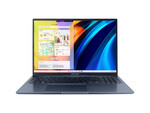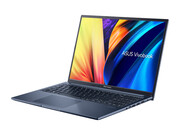Asus Vivobook 16X M1603, R7 5800H
Especificaciones de Portátil(es)

Price comparison
Análisis para el Asus Vivobook 16X M1603, R7 5800H
Origen: Laptop Media
 EN→ES
EN→ESWhen you want a laptop that has the performance of a big gaming machine, you need to make sacrifices. Especially if you want it to be affordable. Well, this is exactly the case with the Vivobook 16X (M1603). Its IPS panel has a WUXGA resolution, 16:10 aspect ratio, comfortable viewing angles, and a good contrast ratio. Its backlight doesn’t use PWM for brightness adjustment, but on the other hand, the color coverage is only 50% of the sRGB color gamut. Although the laptop is made out of plastic, it has one strong feature when it comes to the body – its coating. ASUS has covered all body panels with an antimicrobial layer, which attracts all microbes and then kills them off. Quite sadistic, but also beneficial. In addition to that, the port selection is robbed of an SD card reader, while the USB Type-C port can only be used for data transfers. Also, some of the memory (8GB to be precise) has been soldered to the motherboard. Further expansions are possible via the single SODIMM slot. In terms of battery, you get between 8 and 10 hours on a single charge, depending on your activities – watching videos, or browsing the Web. Using more demanding software, however, will drain it significantly more quickly, due to the power-hungry processor. Speaking of which, it is really powerful. Even though it is a couple of generations old, one can still reap the benefits of AMD’s bold design back in the day. So, if you are looking for a machine that is capable of delivering all you need, at a low price, and still allows you to play light games – get the Vivobook 16X (M1603). Don’t miss to check out the OLED version of this device.
Único Análisis, disponible online, Muy largo, Fecha: 02/23/2023
Origen: Laptop Media

Support, disponible online, Muy corto, Fecha: 02/23/2023
Comentario
AMD Vega 8:
Tarjeta gráfica integrada de las APU Ryzen basadas en la arquitectura Vega con 8 CU (= 512 shaders) y una velocidad de hasta 1,750 MHz.
Estas tarjetas también deben ser capaces de aguantar todos los juegos actuales, pero la mayoría de ellos en configuraciones de detalles medios y bajos y con bajas resoluciones. Juegos más antiguos, o menos exigentes todavía pueden ser jugados con buena calidad de gráficos.
>> Más información puede ser encontrada en nuestra comparación de tarjetas gráficas moviles y la lista de benchmarks.
R7 5800H:
APU móvil octa-core que utiliza núcleos Zen 3 a una frecuencia de 3,2 a 4,4 GHz y una tarjeta gráfica Vega con 8 CUs a una frecuencia de hasta 2000 MHz.
>> Más información puede ser encontrada en nuestra comparación de procesadores móviles.




